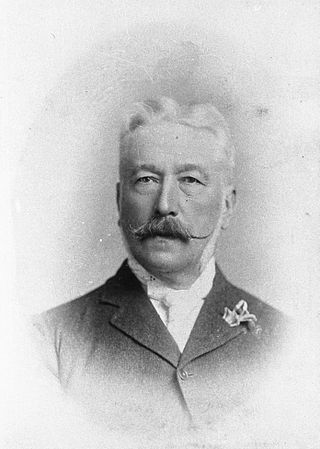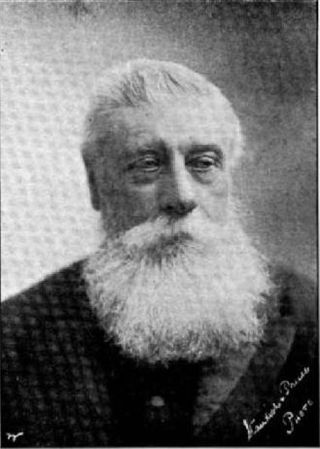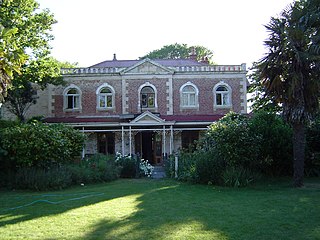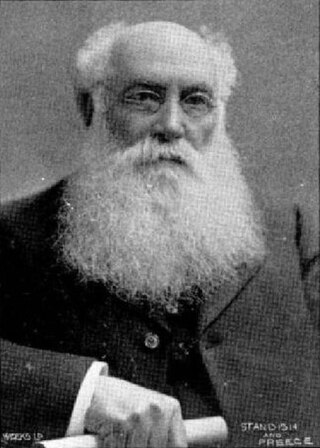
Papanui is a major suburb of Christchurch, New Zealand. It is situated five kilometres to the northwest of the city centre. Papanui has a population of 3,645 consisting predominantly of Pākehā 86.9%, Asian 7.6%, Māori 5.3%, Pacific peoples 3.1%, Middle Eastern/Latin American/African 0.7%. The suburb is located at the junction of three busy thoroughfares; Papanui Road leading to the city, the Main North Road that leads to North Canterbury and Harewood Road that leads to Christchurch International Airport. However, as with most Christchurch suburbs, Papanui has no defined borders.

Edward Cephas John Stevens was a New Zealand politician in provincial government in Canterbury, and a member of both the lower and upper houses of parliament. A businessman, he controlled the Christchurch Press for many decades. He was instrumental in introducing cricket to Canterbury and one of his dealings as a land and estate agent resulted in the creation of Lancaster Park.

Henry Richard Webb JP FRMS was a New Zealand businessman and politician. He represented Lyttelton in Parliament for 2½ years and was a supporter of education in his later years. Born in Australia, he came to Canterbury in 1868.
William Thomson was a 19th-century politician from Christchurch, New Zealand, originally from Scotland. He held office at all levels of government, from Parliament and Provincial Council to chairman of a road board. In his professional life, Thomson was an auctioneer, accountant and commission agent. He had rural holdings in Governors Bay and at the Esk River.
Brian Patrick Ashby was the fifth Catholic Bishop of Christchurch, New Zealand. He was appointed by Pope Paul VI on 11 July 1964, resigned the see on 4 July 1985, and died on 5 June 1988. He was the leading New Zealand Catholic bishop in attempting to implement the decrees of the Vatican Council II and he was the leading bishop on social justice issues.

Holy Trinity Avonside was a heritage-listed Anglican church located in Linwood, Christchurch, New Zealand. It was registered as a "Historic Place – Category I" by the New Zealand Historic Places Trust. The church building was "damaged beyond the point of repair" in the February 2011 Christchurch earthquake and was demolished the following September.

Linwood House was built as the homestead for Joseph Brittan, who, as surgeon, newspaper editor and provincial councillor, was one of the dominant figures in early Christchurch, New Zealand. The suburb of Linwood was named after Brittan's farm and homestead. Brittan's daughter Mary married William Rolleston, and they lived at Linwood House following Joseph Brittan's death. During that time, Rolleston was the 4th Superintendent of the Canterbury Province, and Linwood House served for many important political and public functions.

Joseph Brittan was a New Zealand surgeon, newspaper editor, and provincial councillor, was one of the dominant figures in early Christchurch. Born into a middle-class family in southern England, he followed his younger brother Guise Brittan to Christchurch, where he and his wife arrived in February 1852 with four children. Joseph Brittan soon got involved in the usual activities of early settlers and gained prominence in doing so. He had bought 100 acres on 10 July 1851 and took up 50 of this to the east of Christchurch that he converted to farmland. There, he built the family residence, and the suburb of Linwood was subsequently named after Brittan's farm and homestead of Linwood House.
Sir Kenneth Macfarlane Gresson was a New Zealand soldier, lawyer, university lecturer and judge. He was born on 18 July 1891 and attended Rangi Ruru. His father, John Beatty Gresson, was a solicitor in Christchurch, who died in a railway accident a few months before Kenneth Macfarlane Gresson was born. His grandfather, Henry Barnes Gresson, was one of New Zealand's first Supreme Court judges. He was buried in a family grave at St Paul's Anglican Church, Papanui.
Thomas Scholfield Foster, commonly known as Tony Foster, was a New Zealand school principal and inspector, and university lecturer.

Karori Cemetery is the second-largest cemetery in New Zealand. It opened in 1891, and is located in the Wellington suburb of Karori.

St Saviour's at Holy Trinity is an Anglican church in Lyttelton, Christchurch, New Zealand. St Saviour's Chapel was relocated from West Lyttelton to Christchurch's Cathedral Grammar School in the 1970s. Following the earthquakes and the demolition of Holy Trinity Church, Lyttelton, St Saviour's was returned to Lyttelton to the site of Holy Trinity in 2013.

Samuel Charles Farr was a 19th-century builder and architect in Christchurch, New Zealand. He intended to emigrate from England to Auckland, but significant shipping problems saw him end up in Akaroa in 1850 instead. From 1862, he lived in Christchurch. Farr has a number of firsts against his name: the first marriage in Canterbury, he designed Akaroa's first church, designed New Zealand's first iron verandahs, and he started Sunday schools in Canterbury. As a leading member of the Acclimatisation Society, he stocked almost every lake and river in Canterbury with fish and was instrumental in introducing the bumblebee to New Zealand. His most notable building was Cranmer Court, the former Normal School, in the Christchurch Central City; this building was demolished following the February 2011 Christchurch earthquake.

William Guise Brittan, mostly known as Guise Brittan and commonly referred to as W. G. Brittan, was the first Commissioner of Crown Lands for Canterbury in New Zealand.
Captain Charles Simeon was one of the members of the Canterbury Association who emigrated to Canterbury in New Zealand in 1851. The family spent four years in the colony and during this time, he held various important posts and positions. He returned to England in 1855. He was devoted to the Anglican church and three of his sons became priests, while two of his daughters married priests.

Sir Joseph James Kinsey was a businessman, collector, and philanthropist from Christchurch, New Zealand. He was deeply connected to the Antarctic expeditions of Sir Ernest Shackleton (1874–1922) and Captain Robert Falcon Scott (1868–1912).
Robert William England was a New Zealand architect from Christchurch.

St Peter's Church is an Anglican church in Riccarton, Christchurch, New Zealand. It is registered as Category II by Heritage New Zealand.
Maria Thomson was a New Zealand businesswoman. She established a private school and invested in property in Christchurch in the late nineteenth century.













